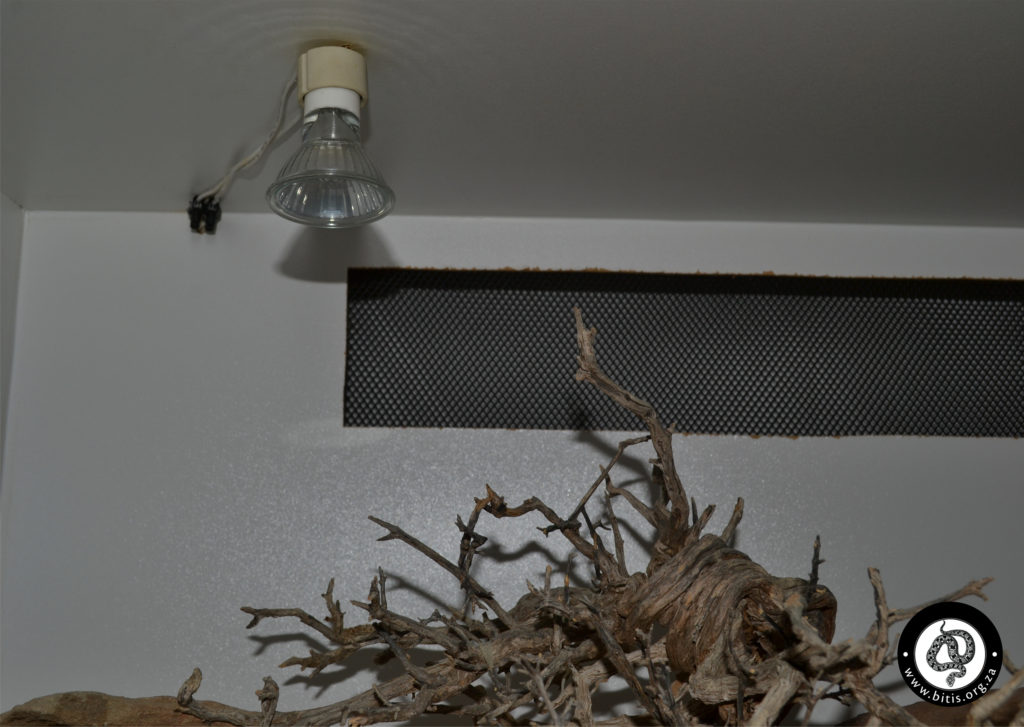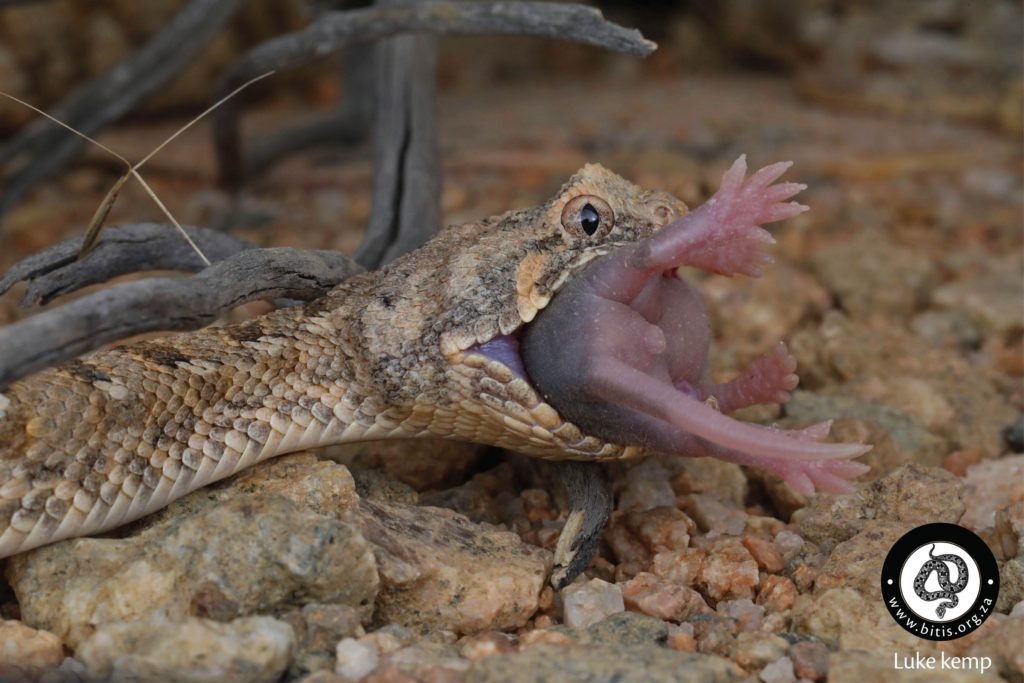Adders in captivity
All Bitis species have their own unique needs. Photoperiod, temperature and humidity, cage decor and substrate all affect behavior and stress levels in a captive snake. However there are a few captive guidelines which apply to them all.
1. ADDERS SHOULD BE FED SPARINGLY
The diet of a wild adder is far more diverse than the “rodent heavy” diet they are subjected to in most captive environments. Wild adders will feed on rodents however they also feed on geckos, lizards, amphibians and possibly other snakes. Laboratory mice have a very different nutritional composition than a lizard or a frog so it is recommended that the feeding schedule considers this. Additionally, adders are generally fed larger meals in captivity than they would eat naturally and as a result captive animals can be quite easily overfed. It is important to monitor the condition of the snake and adjust its feeding routine if necessary. Juvenile adders can be fed more often than adults, however once they reach sub-adulthood feeding should be slowed.
2. MOST ADDERS LIKE TO BASK
Most adders, even those known to be crepuscular or nocturnal will bask under a heat lamp if it is provided, particularly in winter. A hot spot of 35° C in an enclosure large enough to allow for a temperature gradient on the opposite side works for most species. The temperature gradient is essential to prevent heat stress and to allow the snake to determine optimum body temperature when digesting food or developing offspring. Coastal species may prefer a slightly cooler hotspot and slightly higher humidity. Ideally provide a variety of laying points around the basking spot.
3. ADDERS DONT LIKE A DRAFT
While ventilation and fresh air is very important in a reptile room dwarf adders should not be exposed to air draft, particularly cool air. The enclosures should be set up in such a way that fresh air brought into the room does not blow through the cage.

As a side note stagnant air means poor air quality, so make sure the air in the room is changed regularly, ideally via a mechanical method such as an extractor fan. These are relatively inexpensive and easy to install and will guarantee regular air changes in your reptile room. Some keepers report drastically fewer health problems with their adders after addressing this issue.
4. MOST ADDERS WILL DRINK FROM A WATERBOWL
While it is true that many species get their quota of water by drinking the dew off their scales almost all will still drink from a water bowl in captivity if provided. Coastal species such as Bitis peringueyi or Bitis schneideri, which are adapted to drinking off their bodies should be misted instead.
5. ADDERS REQUIRE SPACE
Although adders are ambush predators they do move around and most will utilize an entire cage space no matter how big it is. They will also move between various ambush positions so be sure to provide them with enough space and cage furnishings to do so. Larger enclosures also allow for providing better thermal gradients so always think bigger rather than smaller, though this does not necessarily apply when housing babies.
While enclosure size for all snakes has been debated for many years a generally accepted minimum enclosure size for an adult dwarf adder is,
(L) – 1.5 times the snakes length (min. 600mm)
(W) – 1 times the snakes length (min. 300mm)
(H) – 0.75 times the snakes length (min. 300mm)

6. ADDERS ARE NOT FOR BEGINNERS
Large and dwarf adders should not be recommended to keepers without an intermediate or advanced level of experience, and reasons for this include,
- These are venomous snakes, and in some instances a bite may be fatal. They can be highly irascible and eager to strike at the slightest provocation.
- They have very particular husbandry requirements. Whether environmental, feeding, enclosure setup, many species have unique needs which can be difficult to meet, and if ignored result in an unhappy snake.
All captive venomous snakes should be housed in a secure, lockable enclosure inside a lockable, escape-proof room, and adders are no different. It is important to ensure that should a snake manage to escape it’s enclosure it should not be able to escape from the room. Often this requires the person responsible inspecting the corners of the room, checking there are no gaps under the door, or means of escape through the roof.
Feeding tips
If you have a snake which will not feed, there are a few things you could try.
Tease-feeding
This is effective in baby adders. With a prey item in a pair of forceps tap the nose of the snake to encourage it to bite the prey. Typically they will strike and release, if the snake was able to get a full bite into the prey drop it in the cage and leave the room. Very often the snake will have eaten the prey when you return. Often this works better in a smaller feeding container rather than in the snakes enclosure. Interestingly, certain localities within 1 species may respond differently to teasing. Some may respond to a tail tapping rather than on the nose, and vice versa, so mix it up.
Try different prey
Snakes naturally feed on a variety of prey and some may have a preference for a food item other than the one you are offering, even a different colour.
Scenting
If you want the snake to switch to the prey you are offering you could try scenting. Scenting refers to the practice of transferring the scent of one prey item onto another in the hope this encourages the snake to eat. You will want to reduce this over time so that eventually the snake is feeding on non-scented food items.
Revise your setup
Make sure the enclosure is set up correctly, have you provided the necessary temperature and humidity gradients, adequate hiding spots to allow the snake to feel safe. Appropriate husbandry is crucial for the well-being of any animal.
Tube-feeding
Some keepers use the tube-feeding method to get food into the stomach of the snake. This is done via a feeding tube or a straightened crop needle on the end of a syringe filled with the food. This could be minced prey or a feeding supplement such as Hills AD.
Force-feeding
As a last resort you may need to force-feed a snake. This is done by lubricating a prey item using a natural lubricant (egg albumen works well) and gently inserting it a short distance down the throat of the snake. Once the food item is in the gullet the snake will often finish swallowing themselves.
Do not attempt the last 2 if you are a beginner or not comfortable handling a venomous snake. Instead find an experienced keeper willing to assist.

Please note: This information serves only as a suggestion and is based on input from various experienced keepers. It is important that you gather as much info from various sources before deciding how best to care for your snake. Be sure to check with your local authorities what permits may be required in your area.
